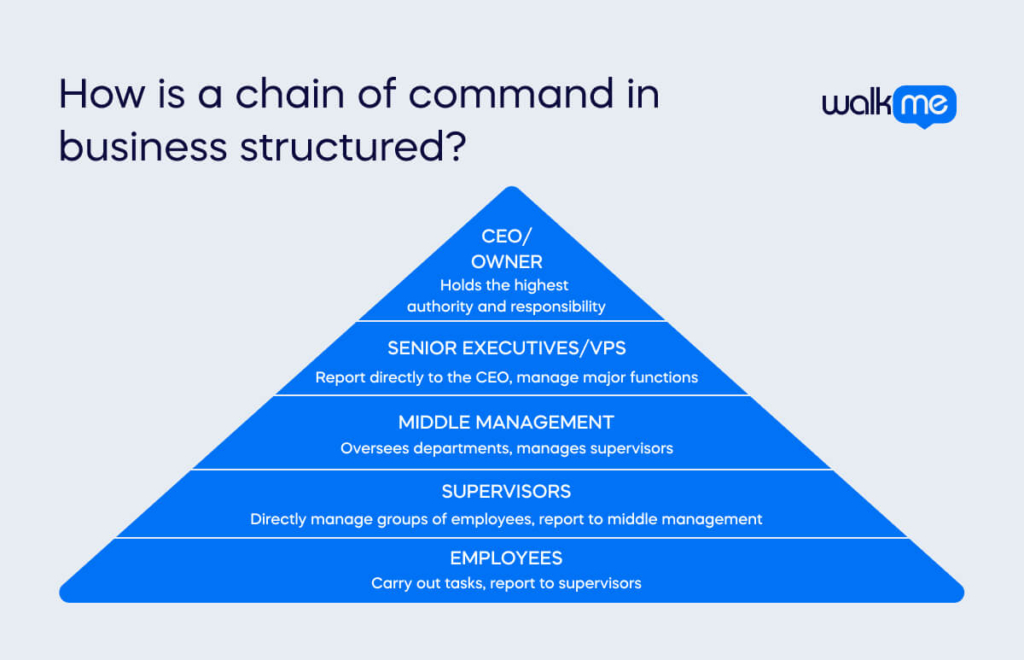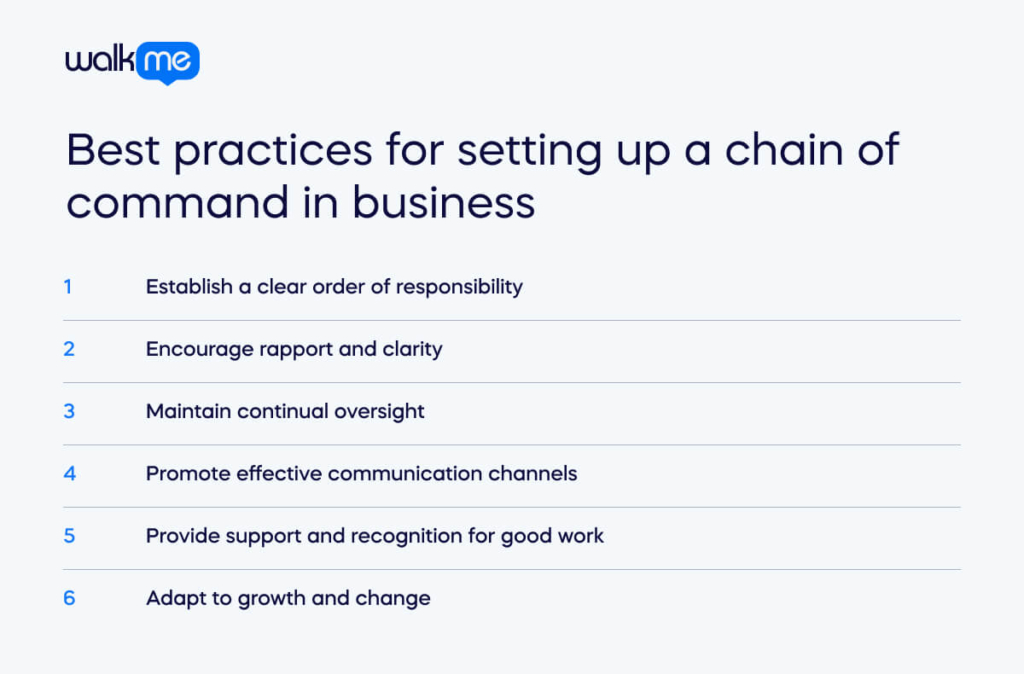In any business environment, it’s typical for some individuals to have more expertise than others. A chain of command ensures that those with the highest expertise have the most influence.
This structure prevents less skilled individuals from overriding those with superior skills or qualifications, which could be the case because they are more vocal or assertive. This structure enhances employee productivity and ensures employers maximize each individual’s potential.
This article will explore the importance of a chain of command in business. We will also examine its structure, benefits, and challenges. Then, we will analyze best practices for implementation and the difference between a vertical and flat chain of command.
What is a chain of command in business?
A chain of command in business outlines who reports to whom and the roles of each person in the organization. It is crucial because it clarifies everyone’s position. It also directs them to the right person for questions or concerns.
The chain of command includes various levels. It starts with senior executives at the top and ends with entry-level employees at the bottom. Between these levels are sales, marketing, human resources, and finance departments. Each has distinct roles and responsibilities.
Why is a chain of command in business important?
A chain of command in business is important as it supports less experienced employees. It helps them feel confident in suggesting innovative ideas and developing their skills.
It fosters cross-functional collaboration and ensures physical and emotional safety. It does this while safeguarding the company from risk. A company in any industry, whether food or logistics, has or needs a chain of command to function well.
How is a chain of command in business structured?

You can structure a chain of command in business according to their level of authority. Various organizations, from software-focused businesses to scientific entities, use this structure. The business owner or CEO sits at the top of the chain of command. Senior executives or vice presidents, who report to the owner or CEO, occupy the next level.
Managers or supervisors oversee departments or groups of employees. They fall under middle management and report to their supervisors. The hierarchy may have more management levels depending on the company’s size and number of departments. The number of management levels varies based on business needs.
The lower your position in the hierarchy, the less authority you hold. Those at the top have more control and make important decisions. They also bear more responsibility for the company’s success and everyone in the chain of command.
Flat chain of command Vs. vertical chain of command?
A flat chain of command features few or no levels of hierarchy. As you move up, fewer people report to you. With these types of hierarchies, fewer middle managers exist.
Employees hold more power and control over their work and environments. Businesses might choose a flatter chain of command to speed up decision-making and foster collaboration.
In contrast, a vertical chain of command follows a traditional hierarchical model where each level reports to the one above it. This structure establishes clear lines of authority and responsibility. It lets everyone know who is in charge and who to consult for decisions.
A vertical chain of command can streamline decision-making and provide employees with a clear understanding of their roles and responsibilities.
Best practices for setting up a chain of command in business

Creating an effective chain of command goes beyond assigning authority. It involves understanding personalities and relationships. You must match people to roles that suit them best for smooth operations.
Here are some best practices to help you begin:
Establish a clear order of responsibility
To create an effective chain of command, determine your second-in-command, third-in-command, and so forth. Each person chosen should match their role’s responsibilities. They should also possess change leadership skills and respect authority. Take time to find individuals who embody these qualities. This is crucial for smooth operations.
Strong leaders are pivotal to the cohesion of your chain of command. Their capability and suitability for leadership roles determine the productivity at each level. Identifying and empowering such leaders ensures effective management and operational success.
Encourage rapport and clarity
Building good rapport among staff helps prevent confusion and resentment due to miscommunications. Ensure everyone understands the chain of command to preempt potential issues. Equip your team with the necessary tools, knowledge, education, and training opportunities. Foster mentorship and support their growth as both workers and potential leaders.
Maintain continual oversight
As a business owner, your leadership involves communicating the company’s vision and goals. Conduct regular staff meetings to discuss big-picture items and business rules. Encourage participation and feedback from all employees to maintain transparency and alignment.
Promote effective communication channels
Establish effective communication channels so everyone knows whom to approach for issues or guidance. Use team communication software to help improve communication throughout the hierarchy. Test these channels to ensure they function well before adopting a hands-off approach.
Provide support and recognition for good work
Stay informed about your employees’ work and knowledge to avoid them seeking information outside the chain of command. Offer support and recognition through non-monetary rewards and specific praise for their contributions. Positive reinforcement motivates employees and strengthens team cohesion.
Adapt to growth and change
Review and update your chain of command and organizational chart as your business evolves. Conduct audits to assess the structure’s efficiency and alignment with current needs. Make adjustments as necessary to optimize productivity and maintain organizational effectiveness.
What are the benefits of having a chain of command in business?

The various advantages of adopting a chain of command in business are:
Better conflict resolution
A well-defined chain of command helps prevent disputes and misunderstandings between team members and departments. Everyone understands their position and role within the organizational structure. As a result, you can resolve disagreements with minimal disruption.
Efficient problem-solving and decision-making
When an employee reports to a single supervisor, there’s closer collaboration and faster problem-solving. For example, a team member dealing with a marketing issue can receive guidance from their supervisor. They will understand that department operations well. Then, if required, the supervisor can escalate the problem to upper management.
Clarity of roles and responsibilities
Each position in the chain of command has clear roles and responsibilities. This feature eliminates overlaps and increases productivity. It also ensures accountability across the organization and creates clear career paths, boosting morale and reducing turnover.
More accountability for your actions
A well-established chain of command clarifies accountability for each employee. Employees know who to approach for decisions or guidance, reducing confusion and ensuring efficient operations. As a result, this chain of command structure minimizes miscommunication and supports quick, effective decision-making.
Enhanced support and stability
In a structured chain of command, employees have clear work goals. They also know whom to approach for feedback or support. This stability enhances their sense of control and stability in the workplace.
It contributes to their job satisfaction and performance. This consistency fosters a sense of direction and purpose among employees, which can lead to a more efficient and productive workplace.
Defined grouping that allows better task management
You can group employees into smaller teams with specific tasks. These can be overseen by supervisors or managers who track performance. This structured approach allows managers to focus on department-specific tasks. This ensures efficient management and employee productivity.
What are the challenges of having a chain of command in business?

But, there are various challenges to having a chain of command in business. These are:
Impact on morale and collaboration
A strict chain of command in business can affect employee and managerial morale. It can create power dynamics where individuals lower down the chain feel that the top does not value their opinions and contributions.
This sense of undervaluation can lead to lower morale and reduced motivation among employees. This is because they may perceive limited opportunities to contribute to organizational goals.
Silos and communication barriers
One of the key drawbacks of a strict chain of command is the formation of silos. Departments or teams may become isolated from one another. This leads to communication barriers and a lack of collaboration across the business.
This siloed approach can hinder information sharing and cross-functional problem-solving efforts. Breaking down these silos is essential for fostering a culture of openness. This is where all employees feel respected and heard, regardless of their position in the hierarchy.
Reduced flexibility and innovation
In a rigid chain of command, decision-making tends to be centralized. Middle managers and employees may have a degree of autonomy in their day-to-day tasks. But, senior management determines the ultimate authority and strategic direction.
This centralized decision-making process can stifle innovation. Lower-level employees may feel constrained by strict guidelines, and there will be fewer opportunities for them to experiment with new ideas or approaches. Thus, the organization may struggle to adapt to changes in the market or industry trends.
Slower decision-making processes
Hierarchical structures often involve multi-layered approval processes for significant decisions. This can lead to delays in decision-making. This is because decisions must pass through several levels of management before you complete them.
These bureaucratic processes can slow the organization’s response time to emerging opportunities or challenges. This can impact its competitiveness and agility in the marketplace.
Some businesses opt to flatten their hierarchy to enhance organizational agility. They could also empower lower-level employees to make more autonomous decisions. By reducing hierarchical layers, businesses can streamline decision-making processes.
This enables faster responses to market demands and customer needs. This approach also encourages a culture of trust and collaboration. In this way, managers and employees work together as partners rather than competitors for authority.
Less employee autonomy
Employees may feel constrained by the need to adhere to hierarchical communication channels. Information flows through formal lines of authority, which can lead to inefficiency and miscommunication.
Individuals may also have limited opportunities to take initiative or contribute ideas outside their roles, which reduces their sense of autonomy and engagement. To mitigate this, organizations should promote open communication channels and empower employees at all levels to take part in decision-making processes.
Final thoughts on having a chain of command in business
Understanding the chain of command is crucial for businesses. It ensures clarity and alignment towards achieving goals. Knowing the reporting relationships prevents confusion and overlaps in responsibilities among team members. This fosters effective communication across all levels of the organization.
Navigating the corporate environment becomes manageable with a clear understanding of this structure. It allows individuals to expect the next steps and make informed decisions. It’s essential to check the roles needed at each level to avoid unnecessary complexity.
Whether large or small, maintaining a well-defined chain of command is vital for operational efficiency in any company.


